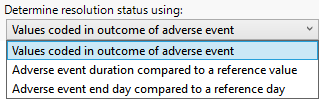Determine resolution status using:
Use this parameter to determine whether an adverse event is considered to be resolved.

Available options are described in the following table:
|
Term Level |
Definition |
|
Values coded in outcome of adverse event |
If you select this response, the variable AEOUT must exist in either the adae or ae domain data set. When the value for this variable is listed either as "RESOLVED" or "RECOVERED", the Adverse Events is considered to be resolved. When the value for this variable is "NOT", the Adverse Events is considered to be unresolved. |
|
AE duration compared to a reference value |
If you select this response, the variable AEDUR must exist in either the adae or ae domain data set. When the value for this variable is less than the specified reference value, the AE is considered to be resolved. When the value for this variable equals or exceeds the specified reference value, the AE is considered to be unresolved. |
|
AE end day compared to a reference day |
If you select this response, the variable AEENDTC must exist in either the adae or ae domain data set. When the value for this variable occurs before the specified reference date, the AE is considered to be resolved. When the value for this variable occurs after the specified reference date, the AE is considered to be unresolved. |
If you select either AE duration compared to a reference value or AE end day compared to a reference day, you must also specify a Reference Value or Day.
To Select the Term Level:
| 8 | Use the drop-down menu to select the desired term level. |